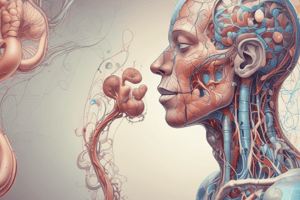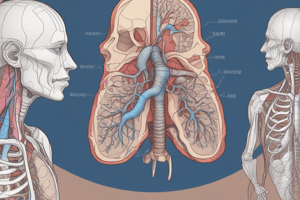Podcast
Questions and Answers
What is the primary function of the nose in the respiratory system?
What is the primary function of the nose in the respiratory system?
- Protection against pathogens
- Air intake (correct)
- Voice production
- Gas exchange
What are the primary functions of the sinuses?
What are the primary functions of the sinuses?
Humidification and warming of air, lightening the skull, and contributing to voice resonance.
The pharynx is solely for the passage of air.
The pharynx is solely for the passage of air.
False (B)
What is the role of the larynx in the respiratory system?
What is the role of the larynx in the respiratory system?
What type of epithelium lines the trachea?
What type of epithelium lines the trachea?
What are the bronchi responsible for?
What are the bronchi responsible for?
What is the function of the alveoli?
What is the function of the alveoli?
The lungs only assist in oxygenating blood.
The lungs only assist in oxygenating blood.
The _____ serves as a shared pathway for air and food.
The _____ serves as a shared pathway for air and food.
Match the parts of the respiratory system to their functions:
Match the parts of the respiratory system to their functions:
Flashcards are hidden until you start studying
Study Notes
Upper Respiratory Tract
-
Nose
- Main entry point for air; filters large particles like dust and pollen with nasal hairs (vibrissae).
- Humidifies and warms air through rich blood supply and mucous membranes, preparing it for the lower respiratory tract.
- Contains olfactory receptors for detecting odors, contributing to the sense of smell.
-
Sinuses
- Humidify and warm incoming air to enhance respiratory function.
- Lighten the skull's weight through air-filled spaces.
- Contribute to voice resonance and quality.
-
Pharynx
- Functions as a shared pathway for air to the lungs and food to the esophagus.
- Contains tonsils that defend against pathogens.
- Aids in swallowing by directing food to the esophagus while protecting the airway.
-
Larynx
- Houses vocal cords; air passing through them enables voice production.
- Acts as a gatekeeper to prevent food and liquids from entering the trachea, aided by the epiglottis.
- Triggers the cough reflex to expel foreign particles from the airway.
Lower Respiratory Tract
-
Trachea (Windpipe)
- Main airway conducting air from the larynx to the bronchi.
- Lined with pseudostratified ciliated columnar epithelium and mucus-producing cells for trapping impurities.
- C-shaped cartilage rings provide structural support while allowing airway flexibility.
-
Bronchi
- Conduct air from the trachea to each lung, branching into secondary (lobar) and tertiary (segmental) bronchi.
- Lined similarly to the trachea with ciliated cells and mucus to trap foreign particles.
- Their branching structure ensures even air distribution to the lungs.
-
Bronchioles
- Smaller airways leading to alveoli, regulating airflow via smooth muscle constriction and dilation.
- Respiratory bronchioles are involved in gas exchange, connecting to alveoli.
-
Alveoli
- Tiny sacs where gas exchange of oxygen and carbon dioxide occurs, featuring thin walls and surrounded by capillaries.
- Alveolar cells produce surfactant to reduce surface tension, preventing collapse and easing breathing.
-
Lungs
- Primary organs for gas exchange, housing bronchi, bronchioles, and alveoli.
- Absorb oxygen into the bloodstream and expel carbon dioxide.
- Contribute to acid-base balance by regulating carbon dioxide levels.
- The pleura (visceral and parietal) and pleural fluid facilitate smooth lung movement and prevent friction during breathing, maintaining lung inflation and preventing collapse.
Physiology of the Respiratory System
-
Pulmonary Circulation
- Essential for reoxygenating blood and releasing carbon dioxide.
-
Pulmonary Arteries
- Carry deoxygenated blood from the heart to the lungs for reoxygenation.
Studying That Suits You
Use AI to generate personalized quizzes and flashcards to suit your learning preferences.




